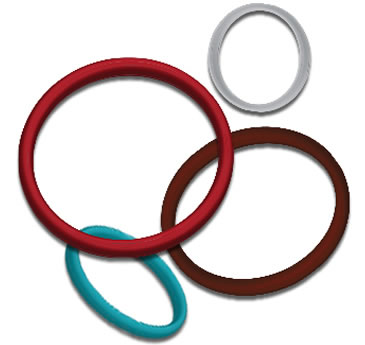
Also known as a toric joint, an O-ring is a gasket consisting of a circular, ring-shaped piece of material. Like other gaskets, it’s used to create a seal. When two parts are joined together, they may be fitted with an O-ring to prevent pressurized liquids or gases from leaking.
To create an effective seal, though, O-rings must be constructed of specific materials. O-rings can’t be made of just any material. If a material is weak or even too rigid, it may fail to withstand the compressive forces of pressurized liquids or gases.
Silicone Rubber
Silicone rubber is a common material used in the construction of O-rings. Silicone rubber O-rings are resistant to both cold and hot temperatures, and they also have a longer lifespan than O-rings made of other materials. Furthermore, food and beverage companies often use them because silicone is considered safe and nontoxic. With these properties, silicone rubber is a popular material for O-rings.
Neoprene
Some O-rings are made of neoprene. Also known as polychloroprene, neoprene is a type of synthetic, manmade rubber. When compared to natural rubber, neoprene offers greater protection against degradation. This means neoprene O-rings can create longer-lasting seals while requiring less-frequent replacing. Neoprene O-rings can also withstand extreme heat. Neoprene doesn’t burn until it’s exposed to heat in excess of 500 degrees Fahrenheit.
Aflas
You may come across O-rings made of Aflas. What is Aflas exactly? It’s a polymer of tetrafluoroethylene (TFE) and propylene. Jargon aside, Aflas is recognized for its superior performance when exposed to oils and other chemicals. While harsh oils and chemicals may eat away at other materials, Aflas will resist them. Therefore, Aflas O-rings are typically used for sealing applications involving oils and chemicals.
Polyurethane
Polyurethane is another common material used in the construction of O-rings. By definition, polyurethane is an organic material that’s jointed via carbamate, urethane links. Polyurethane has many properties that make it an effective choice of material for O-rings. It’s durable, elastic and resistant to moisture. With that said, it doesn’t offer the same level of protection against oils and chemicals as Aflas.
In Conclusion
While all O-rings feature the same shape, they are available in different materials. Some of them are made of silicone rubber, whereas others are made of Aflas or polyurethane. These are just a few materials used in the construction of O-rings. Others include polytetrafluoroethylene, Buna, Viton and more.
